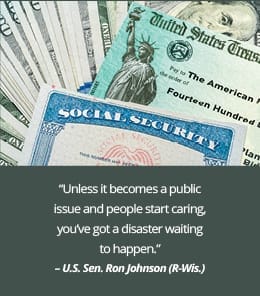

Outagamie County’s Appleton International Airport is sitting on $11.5 million of federal COVID-19 relief money. Despite a formal request from the Badger Institute for documents and an exchange of emails over two months with county finance officials, it remains unclear what the money will be used for and why it hasn’t been spent in the more than 18 months since the funding became available with the passage of the $2.2 trillion Coronavirus Aid, Relief and Economic Security Act (CARES Act).
Madison has $16.1 million of unspent funding. The city plans to use $12.4 million of it for operating assistance in transportation in 2021 and transit capital projects in 2022. When asked what either had to do with COVID or why the money hasn’t been spent yet, the city’s finance director, David Schmiedicke, declined to respond to an email.
Brown County spent $7,951,770 of its allocation covering operational losses at its airport. Another $1,663,300 remained as of July 6, according to county finance director Bradley Klingsporn. When asked to explain why, Klingsporn stopped replying to emails.
Through July, the Badger Institute identified more than $100 million of CARES Act funding that remained to be spent in Wisconsin. That figure is surely much higher. Of the 10 largest counties and 10 largest cities in Wisconsin that we formally asked for an accounting, seven failed to fulfill their legal obligation to respond.
In all, Wisconsin received $2.26 billion in CARES Act funding, according to the Legislative Fiscal Bureau. The City of Milwaukee and Milwaukee and Dane counties got a total of $260 million, and the state distributed another $190 million to more than 1,150 other counties, cities, villages and towns.
While each of those government entities is bound by CARES Act rules to maintain an accounting, finding out how they spent — or didn’t spend — the money is a matter of filing formal requests of each for documentation.
The Badger Institute undertook tracking down CARES Act spending in the state because, frankly, no one else is doing it. The bill was an emergency action, meant to quickly get funding into and out of the hands of health professionals and related government agencies. It’s why conservatives like Johnson and Steil are demanding to know why emergency money has gone unspent after a year and a half.
And without such an accounting, it’s impossible for lawmakers at every level of government to know how much of the deluge of $4.7 trillion in six separate COVID relief bills, including CARES, was necessary or came close to doing what it was supposed to do.
The lack of accounting of the CARES Act funding is the cause of great frustration and one of the principal reasons U.S. Sen. Ron Johnson and U.S. Rep. Bryan Steil, both Wisconsin Republicans, voted against the CARES followup, the $1.9 trillion American Rescue Plan Act (ARPA), passed in March. Both voted for the CARES Act in March 2020. Steil says he has sent a series of letters to Gov. Tony Evers asking for a breakdown of CARES Act spending.
Steil described the response from the governor as “de minimis,” or inconsequential.
Both Steil and Johnson contend that the unspent money is proof that state and local governments didn’t need the CARES Act, let alone the ARPA, bailouts. They point to a memo from the Legislative Fiscal Bureau showing that general fund tax collections during fiscal year 2020-’21 under the COVID cloud were nearly 12% higher than they were the previous fiscal year.
“It’s mind-blowing the amount of money we’ve spent, and we have no idea how or why it was spent,” Steil told the Badger Institute. “There are supposed to be some lessons in how the CARES Act money was spent, and we don’t have them, which is why I voted against the $1.9 trillion (ARPA).”
Lax oversight and reporting requirements at the federal level helped obscure the fact that ARPA wasn’t necessary, Johnson says. “The whole approach to COVID was insane,” he says. “We spent so much more money than was needed.”

This isn’t to suggest that no one is keeping track of COVID spending. There is the federal Pandemic Oversight tracker and the Wisconsin Department of Administration’s COVID Spending Dashboard.
The DOA’s Routes to Recovery guidelines are very explicit in requiring local governments to document the amount of every expenditure, the date it was paid, which department paid it, who received it and how the expenditure was related to dealing with the pandemic.
While the DOA has collected spending totals from those 1,164 local governments, the itemized spending and the documentation in support of that spending stay with the municipalities, unless requested by the DOA. And if a citizen in Kaukauna wants to know how much of its original CARES Act allocation the city has not yet spent, he or she must make an open records request to find out.
At the federal level, the people whose job it is to keep track have stopped breaking out the unspent funds by individual spending bills. As of mid-June, more than $1 trillion in COVID relief had not yet been spent, according to the most recent report by the Government Accounting Office. The GAO estimated that $210 billion had not yet been spent by state and local governments but provided no breakout of CARES and ARPA funding.
In March, just before ARPA was signed into law, the Committee for a Responsible Federal Budget estimated that $340 billion, most of it CARES Act funding, had not been spent. In the same report, the Committee said that an accounting of at least $70 billion might be impossible because of lax or no reporting requirements.
Congress, as part of a $900 billion COVID booster bill at the end of 2020, extended the CARES Act spending deadlines for everyone until the end of 2021. Most of the ARPA spending deadlines extend out until the end of 2024.
The Evers administration told a Madison television news outlet on Dec. 15, 2020, that Wisconsin had beaten the deadline and spent its entire CARES Act sum. It wasn’t until the last paragraph of the news report that mentioned that less than half of the money — $949 million — had actually been spent. Another $635.9 million was to have been “distributed” by the end of December and $414.3 million had been “allocated” but also not distributed.
“From the start, it’s been smoke and mirrors,” Steil says. “This bill was supposed to have gotten money into people’s hands quickly. Instead, we get this D.C. sleight of hand. And I continue to get stonewalled by the governor’s office at every turn.”
When we contacted the Department of Administration to ask for an accounting of unspent CARES Act funds, the Badger Institute was instructed to contact the individual government caretakers of the data.
In early July, we sent emails making clear our requests were a matter of public record, according to CARES Act guidelines and under the state’s Public Records Law. The cities of Milwaukee, Madison, Green Bay, Waukesha, Eau Claire and Appleton and Milwaukee, Dane, Waukesha, Outagamie, Racine, Brown and Rock counties responded to the requests. The cities of Kenosha, Racine, Oshkosh and Janesville and Winnebago, Kenosha and Washington counties did not.
Two clear themes emerge from the responses to our requests: First, given a very broad COVID impact definition, the extension of deadlines and an ARPA windfall on the way, governments opted to allocate tens of millions of CARES Act dollars to plug holes in their budgets, particularly in the area of transit.
And second, few of the finance directors on the front lines of the CARES Act funding were willing to explain how or why they made their CARES Act budgeting decisions.
In response to our request in early July for a detailed breakdown of unspent funding, City of Milwaukee deputy comptroller Joshua Benson sent an Excel spreadsheet showing three numbers: $178.6 million in CARES Act awards, $135.4 million in expenditures and a balance of $43.2 million.
After failing to get Benson to answer emails asking for a further breakdown and some explanations, the Badger Institute in September reached Jeff Fleming, a spokesman for Mayor Tom Barrett.
Following an extended exchange of emails, Fleming shared a 10-page internal report contradicting the comptroller’s numbers altogether. The city, the report says, received $102.98 million, not $178.6 million, and had spent $101.94 million, not $135.4 million, leaving an unspent balance of a little over $1 million.
Fleming’s last word on the matter was to say the comptroller’s people “always have the least up-to-date information.”
Josh Smith, Rock County administrator, said the influx of ARPA funding and the relaxed deadlines allowed the county to prioritize grants. As a result, the county has yet to spend nearly $1.9 million in CARES Act money, even though it was earmarked almost a year ago for its Infectious Disease Program.
“The receipt of these federal monies has been welcome,” Smith says. “Were it not for these funds, the county would have had to spend down its general fund savings account for pandemic response. “The primary challenge with the CARES funding was the limited amount of time in which to spend the funds. With the timeline for spending ARPA funds significantly longer, we will have much more time to be thoughtful about how spending those funds can have a long-term impact on our community and recovery.”
The independent research group Wisconsin Policy Forum began breaking down the spending totals for the various COVID relief bills with a report in April. It could be many months before it begins the granular work begun by the Badger Institute, says research director Jason Stein.
Other than spending transparency and accountability, Stein says the latitude allowed in this avalanche of spending could cause local governments in the state to put money into new or ongoing programs. During the Great Recession years, Wisconsin poured federal economic bailout money into public schools and Medicaid, only to cut its school and local government funding when the money ran out.
It might take what Stein describes as a “fiscal cliff” to get the attention of American taxpayers, who almost certainly consider the CARES Act old news, Johnson says.
In its zeal to make as many potential voters as happy as possible, Congress surrendered any hope of regulating or accounting for COVID spending.
“Unless it becomes a public issue and people start caring,” Johnson says, “you’ve got a disaster waiting to happen.”
Mark Lisheron is managing editor of Diggings. Permission to reprint is granted as long as the author and Badger Institute are properly cited.